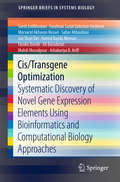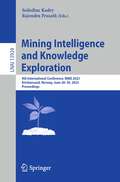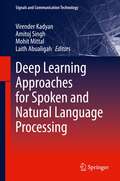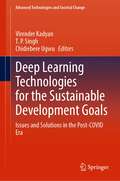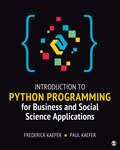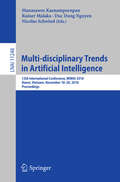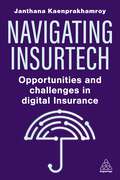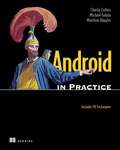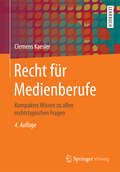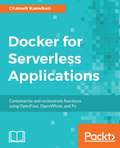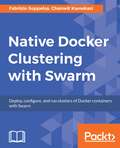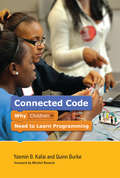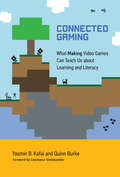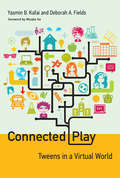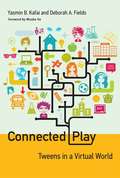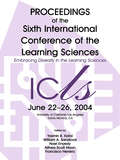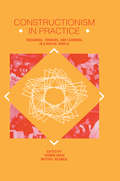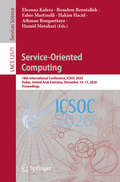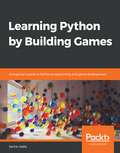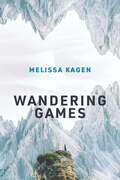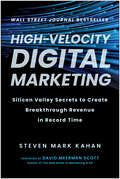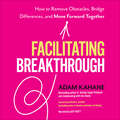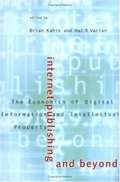- Table View
- List View
Cis/Transgene Optimization: Systematic Discovery Of Novel Gene Expression Elements Using Bioinformatics And Computational Biology Approaches (Springerbriefs In Systems Biology Ser.)
by Saeid Kadkhodaei Farahnaz Sadat Golestan Hashemi Morvarid Akhavan Rezaei Sahar Abbasiliasi Joo Shun Tan Hamid Rajabi Memari Faruku Bande Ali Baradaran Mahdi Moradpour Arbakariya B. AriffThis book is a practical review which focuses on computational analysis and on in silico approaches towards the systematic discovery of various key functional gene expression elements in microalgae as a model. So far, in this regard very little information is available. Efficient stepwise procedures for analysing the matrix attachment regions (MARs) are outlined, as well as for translation initiation sites (TIS), signal peptide (SP) sequences, gene optimization and transformation systems. These outlines can be efficiently deployed as practical models for the systematic discovery of key expression elements and for the optimization of cis/transgenes in other micro/organisms. The first chapter is an introduction on the key gene expression elements analysed in this book, including scaffold/matrix attachment regions, translation initiation sites, signal peptides as well as gene optimization. Chapter 2 focuses on systematic strategies and computational approaches toward in silico analysis of each factor. The analyses outcomes is assessed individually in chapter 3 followed by developing the specific conceptual models for each element in Chapter 4. The concluding remarks are discussed in Chapter 5. This work is of interest to computational and experimental biologists interested in transcriptional regulation analysis as well as to researchers and scientists who wish to consider the use of bioinformatics and computational biology in design, analysis, or regulatory reviews of key gene expression elements for the production of recombinant proteins experiments.
Explainable AI (XAI) for Sustainable Development: Trends and Applications
by Seifedine Kadry Rajesh Kumar Dhanaraj Ravi Shekhar Tiwari Lakshmi D.This book presents innovative research works to automate, innovate, design, and deploy AI fo real-world applications. It discusses AI applications in major cutting-edge technologies and details about deployment solutions for different applications for sustainable development. The application of Blockchain techniques illustrates the ways of optimisation algorithms in this book. The challenges associated with AI deployment are also discussed in detail, and edge computing with machine learning solutions is explained. This book provides multi-domain applications of AI to the readers to help find innovative methods towards the business, sustainability, and customer outreach paradigms in the AI domain.• Focuses on virtual machine placement and migration techniques for cloud data centres• Presents the role of machine learning and meta-heuristic approaches for optimisation in cloud computing services• Includes application of placement techniques for quality of service, performance, and reliability improvement• Explores data centre resource management, load balancing and orchestration using machine learning techniques• Analyses dynamic and scalable resource scheduling with a focus on resource managementThe reference work is for postgraduate students, professionals, and academic researchers in computer science and information technology.
Mining Intelligence and Knowledge Exploration: 9th International Conference, MIKE 2023, Kristiansand, Norway, June 28–30, 2023, Proceedings (Lecture Notes in Computer Science #13924)
by Seifedine Kadry Rajendra PrasathThis book constitutes the refereed post-conference proceedings of the 9th International Conference on Mining Intelligence and Knowledge Exploration, MIKE 2023, held in Kristiansand, Norway, during June 28–30, 2023. The 22 full papers and 16 short papers included in this book were carefully reviewed and selected from 87 submissions. They were grouped into various subtopics including Knowledge Exploration in IoT, Medical Informatics, Machine Learning, Text Mining, Natural Language Processing, Cryptocurrency and Blockchain, Application of Artificial Intelligence, and other areas.
Deep Learning Approaches for Spoken and Natural Language Processing (Signals and Communication Technology)
by Virender Kadyan Amitoj Singh Mohit Mittal Laith AbualigahThis book provides insights into how deep learning techniques impact language and speech processing applications. The authors discuss the promise, limits and the new challenges in deep learning. The book covers the major differences between the various applications of deep learning and the classical machine learning techniques. The main objective of the book is to present a comprehensive survey of the major applications and research oriented articles based on deep learning techniques that are focused on natural language and speech signal processing. The book is relevant to academicians, research scholars, industrial experts, scientists and post graduate students working in the field of speech signal and natural language processing and would like to add deep learning to enhance capabilities of their work.Discusses current research challenges and future perspective about how deep learning techniques can be applied to improve NLP and speech processing applications;Presents and escalates the research trends and future direction of language and speech processing;Includes theoretical research, experimental results, and applications of deep learning.
Deep Learning Technologies for the Sustainable Development Goals: Issues and Solutions in the Post-COVID Era (Advanced Technologies and Societal Change)
by Virender Kadyan T. P. Singh Chidiebere UgwuThis book provides insights into deep learning techniques that impact the implementation strategies toward achieving the Sustainable Development Goals (SDGs) laid down by the United Nations for its 2030 agenda, elaborating on the promises, limits, and the new challenges. It also covers the challenges, hurdles, and opportunities in various applications of deep learning for the SDGs. A comprehensive survey on the major applications and research, based on deep learning techniques focused on SDGs through speech and image processing, IoT, security, AR-VR, formal methods, and blockchain, is a feature of this book. In particular, there is a need to extend research into deep learning and its broader application to many sectors and to assess its impact on achieving the SDGs. The chapters in this book help in finding the use of deep learning across all sections of SDGs. The rapid development of deep learning needs to be supported by the organizational insight and oversight necessary for AI-based technologies in general; hence, this book presents and discusses the implications of how deep learning enables the delivery agenda for sustainable development.
Introduction to Python Programming for Business and Social Science Applications
by Paul Kaefer Frederick KaeferWould you like to gather big datasets, analyze them, and visualize the results, all in one program? If this describes you, then Introduction to Python Programming for Business and Social Science Applications is the book for you. Authors Frederick Kaefer and Paul Kaefer walk you through each step of the Python package installation and analysis process, with frequent exercises throughout so you can immediately try out the functions you’ve learned. Written in straightforward language for those with no programming background, this book will teach you how to use Python for your research and data analysis. Instead of teaching you the principles and practices of programming as a whole, this application-oriented text focuses on only what you need to know to research and answer social science questions. The text features two types of examples, one set from the General Social Survey and one set from a large taxi trip dataset from a major metropolitan area, to help readers understand the possibilities of working with Python. Chapters on installing and working within a programming environment, basic skills, and necessary commands will get you up and running quickly, while chapters on programming logic, data input and output, and data frames help you establish the basic framework for conducting analyses. Further chapters on web scraping, statistical analysis, machine learning, and data visualization help you apply your skills to your research. More advanced information on developing graphical user interfaces (GUIs) help you create functional data products using Python to inform general users of data who don’t work within Python. First there was IBM® SPSS®, then there was R, and now there′s Python. Statistical software is getting more aggressive - let authors Frederick Kaefer and Paul Kaefer help you tame it with Introduction to Python Programming for Business and Social Science Applications.
Introduction to Python Programming for Business and Social Science Applications
by Paul Kaefer Frederick KaeferWould you like to gather big datasets, analyze them, and visualize the results, all in one program? If this describes you, then Introduction to Python Programming for Business and Social Science Applications is the book for you. Authors Frederick Kaefer and Paul Kaefer walk you through each step of the Python package installation and analysis process, with frequent exercises throughout so you can immediately try out the functions you’ve learned. Written in straightforward language for those with no programming background, this book will teach you how to use Python for your research and data analysis. Instead of teaching you the principles and practices of programming as a whole, this application-oriented text focuses on only what you need to know to research and answer social science questions. The text features two types of examples, one set from the General Social Survey and one set from a large taxi trip dataset from a major metropolitan area, to help readers understand the possibilities of working with Python. Chapters on installing and working within a programming environment, basic skills, and necessary commands will get you up and running quickly, while chapters on programming logic, data input and output, and data frames help you establish the basic framework for conducting analyses. Further chapters on web scraping, statistical analysis, machine learning, and data visualization help you apply your skills to your research. More advanced information on developing graphical user interfaces (GUIs) help you create functional data products using Python to inform general users of data who don’t work within Python. First there was IBM® SPSS®, then there was R, and now there′s Python. Statistical software is getting more aggressive - let authors Frederick Kaefer and Paul Kaefer help you tame it with Introduction to Python Programming for Business and Social Science Applications.
Multi-disciplinary Trends in Artificial Intelligence: 12th International Conference, MIWAI 2018, Hanoi, Vietnam, November 18–20, 2018, Proceedings (Lecture Notes in Computer Science #11248)
by Manasawee Kaenampornpan Rainer Malaka Duc Dung Nguyen Nicolas SchwindThis book constitutes the refereed conference proceedings of the 12th International Conference on Multi-disciplinary Trends in Artificial Intelligence, MIWAI 2018, held in Hanoi, Vietnam, in November 2018. The 16 full papers presented together with 9 short papers were carefully reviewed and selected from 65 submissions. They are organized in the following topical sections: control, planning and scheduling, pattern recognition, knowledge mining, software applications, strategy games and others.
Navigating Insurtech: Opportunities and Challenges in Digital Insurance
by Janthana KaenprakhamroyNavigating Insurtech demystifies the insurtech ecosystem, providing insurance professionals with a comprehensive understanding of the industry and its key players, components, challenges and opportunities. The insurtech landscape is highly complex and constantly evolving, making it difficult to fully understand its opportunities and challenges. Yet insurance companies that fail to evolve and grasp advancements in insurtech could risk losing market share and suffer reputational damage. This book offers practical guidance for insurance companies looking to implement insurtech solutions, supported throughout by real-life case studies, insights and interviews from industry leaders and experts. It examines key developments, such as customer experience, risk management, distribution channels and transformative technologies such as blockchain, IoT and AI. It also looks at the investment landscape, offering insights into successful insurtech investments, opportunities and challenges of investing in insurtech startups.To succeed in insurtech, organizations must have a deep understanding of the industry and the technologies involved, as well as the ability to build strong partnerships with other players in the ecosystem. Navigating Insurtech is an essential read for insurance and insurtech professionals, investors and anyone else interested in the developments of insurtech.
Android in Practice
by Matthias Kaeppler Michael Galpin Charlie CollinsSummaryAndroid in Practice is a treasure trove of Android goodness, with over 90 tested, ready-to-use techniques including complete end-to-end example applications and practical tips for real world mobile application developers. Written by real world Android developers, this book addresses the trickiest questions raised in forums and mailing lists. Using an easy-to-follow problem/solution/discussion format, it dives into important topics not covered in other Android books, like advanced drawing and graphics, testing and instrumentation, building and deploying applications, and using alternative languages.About the BookIt's not hard to find the information you need to build your first Android app. Then what? If you want to build real apps, you will need some how-to advice, and that's what this book is about. Android in Practice is a rich source of Android tips, tricks, and best practices, covering over 90 clever and useful techniques that will make you a more effective Android developer. Techniques are presented in an easy-to-read problem/solution/discussion format. The book dives into important topics like multitasking and services, testing and instrumentation, building and deploying applications, and using alternative languages. Purchase of the print book comes with an offer of a free PDF, ePub, and Kindle eBook from Manning. Also available is all code from the book. What's InsideTechniques covering Android 1.x to 3.xAndroid for tabletsWorking with threads and concurrencyTesting and buildingUsing location awareness and GPSStyles and themesAnd much more!This book requires a working knowledge of Java, but no prior experience with Android is assumed. Source Code can be found at https://code.google.com/p/android-in-practice/Table of ContentsPART 1 BACKGROUND AND FUNDAMENTALSIntroducing AndroidAndroid application fundamentalsManaging lifecycle and statePART 2 REAL WORLD RECIPESGetting the pixels perfectManaging background tasks with ServicesThreads and concurrencyStoring data locallySharing data between appsHTTP networking and web servicesLocation is everythingAppeal to the senses using multimedia2D and 3D drawingPART 3 BEYOND STANDARD DEVELOPMENTTesting and instrumentationBuild managementDeveloping for Android tablets
Recht für Medienberufe
by Clemens KaeslerMit diesem Buch finden Sie sich schnell im Dschungel der medienspezifischen Rechtsfragen zurecht. Es orientiert sich am Lehrplan und hilft Ihnen, die für Ihren Beruf relevanten Themen schnell zu begreifen und mit ihnen umgehen zu können. Insbesondere liegt der Schwerpunkt auf dem Urheberrecht, dem Kennzeichen- und Markenrecht, dem Internetrecht, dem Wettbewerbsrecht sowie dem Datenschutz und Presserecht.
Docker for Serverless Applications: Containerize and orchestrate functions using OpenFaas, OpenWhisk, and Fn
by Chanwit KaewkasiBuild applications and infrastructures that leverage Function-as-a-Service and DockerKey Features- Implement containerization in Serverless/FaaS environments- Utilize Docker as a functional unit of work for Serverless/FaaS platforms- Use Docker as a portable infrastructure for Serverless ApplicationsBook DescriptionServerless applications have gained a lot of popularity among developers and are currently the buzzwords in the tech market. Docker and serverless are two terms that go hand-in-hand.This book will start by explaining serverless and Function-as-a-Service (FaaS) concepts, and why they are important. Then, it will introduce the concepts of containerization and how Docker fits into the Serverless ideology. It will explore the architectures and components of three major Docker-based FaaS platforms, how to deploy and how to use their CLI. Then, this book will discuss how to set up and operate a production-grade Docker cluster. We will cover all concepts of FaaS frameworks with practical use cases, followed by deploying and orchestrating these serverless systems using Docker. Finally, we will also explore advanced topics and prototypes for FaaS architectures in the last chapter.By the end of this book, you will be in a position to build and deploy your own FaaS platform using Docker.What you will learn Learn what Serverless and FaaS applications are Get acquainted with the architectures of three major serverless systems Explore how Docker technologies can help develop Serverless applications Create and maintain FaaS infrastructures Set up Docker infrastructures to serve as on-premises FaaS infrastructures Define functions for Serverless applications with Docker containersWho this book is forIf you are a Developer, a Docker Engineer, a DevOps Engineer, or any stakeholder interested in learning the use of Docker on Serverless environments then this book is for you.
Native Docker Clustering with Swarm
by Chanwit Kaewkasi Fabrizio SoppelsaDeploy, configure, and run clusters of Docker containers with Swarm About This Book • Get to grips with Docker Swarm, one of the key components of the Docker ecosystem. • Optimize Swarm and SwarmKit features for scaling massive applications through containers. • Learn about Docker's scheduling tricks, high availability, security, and platform scalability. Who This Book Is For If you are a Linux admin or a Docker user who wants to natively manage Docker clusters, then this is the book for you. What You Will Learn • Create and manage Swarm Mode clusters of any size • Get a backstage view of the biggest Swarms ever built : Swarm2k and Swarm3k, with their 2,300 and 4,700 nodes • Discovery mechanisms and Raft • Deploy your containerized app on Swarm • Administer Swarm clusters on AWS, Azure, and DigitalOcean • Integrate Flocker volumes with Swarm • Create and manage Swarms on OpenStack Magnum In Detail Docker Swarm serves as one of the crucial components of the Docker ecosystem and offers a native solution for you to orchestrate containers. It's turning out to be one of the preferred choices for Docker clustering thanks to its recent improvements. This book covers Swarm, Swarm Mode, and SwarmKit. It gives you a guided tour on how Swarm works and how to work with Swarm. It describes how to set up local test installations and then moves to huge distributed infrastructures. You will be shown how Swarm works internally, what's new in Swarmkit, how to automate big Swarm deployments, and how to configure and operate a Swarm cluster on the public and private cloud. This book will teach you how to meet the challenge of deploying massive production-ready applications and a huge number of containers on Swarm. You'll also cover advanced topics that include volumes, scheduling, a Libnetwork deep dive, security, and platform scalability. Style and approach A comprehensive guide that covers all aspects of Docker Swarm from setup to customization.
Connected Code: Why Children Need to Learn Programming (The John D. and Catherine T. MacArthur Foundation Series on Digital Media and Learning)
by Yasmin B. Kafai Quinn BurkeWhy every child needs to learn to code: the shift from “computational thinking” to computational participation.Coding, once considered an arcane craft practiced by solitary techies, is now recognized by educators and theorists as a crucial skill, even a new literacy, for all children. Programming is often promoted in K-12 schools as a way to encourage “computational thinking”—which has now become the umbrella term for understanding what computer science has to contribute to reasoning and communicating in an ever-increasingly digital world.In Connected Code, Yasmin Kafai and Quinn Burke argue that although computational thinking represents an excellent starting point, the broader conception of “computational participation” better captures the twenty-first-century reality. Computational participation moves beyond the individual to focus on wider social networks and a DIY culture of digital “making.”Kafai and Burke describe contemporary examples of computational participation: students who code not for the sake of coding but to create games, stories, and animations to share; the emergence of youth programming communities; the practices and ethical challenges of remixing (rather than starting from scratch); and the move beyond stationary screens to programmable toys, tools, and textiles.
Connected Gaming: What Making Video Games Can Teach Us about Learning and Literacy (The John D. and Catherine T. MacArthur Foundation Series on Digital Media and Learning)
by Yasmin B. Kafai Quinn BurkeHow making and sharing video games offer educational benefits for coding, collaboration, and creativity.Over the last decade, video games designed to teach academic content have multiplied. Students can learn about Newtonian physics from a game or prep for entry into the army. An emphasis on the instructionist approach to gaming, however, has overshadowed the constructionist approach, in which students learn by designing their own games themselves. In this book, Yasmin Kafai and Quinn Burke discuss the educational benefits of constructionist gaming—coding, collaboration, and creativity—and the move from “computational thinking” toward “computational participation.” Kafai and Burke point to recent developments that support a shift to game making from game playing, including the game industry's acceptance, and even promotion, of “modding” and the growth of a DIY culture. Kafai and Burke show that student-designed games teach not only such technical skills as programming but also academic subjects. Making games also teaches collaboration, as students frequently work in teams to produce content and then share their games with in class or with others online. Yet Kafai and Burke don't advocate abandoning instructionist for constructionist approaches. Rather, they argue for a more comprehensive, inclusive idea of connected gaming in which both making and gaming play a part.
Connected Play: Tweens in a Virtual World (The John D. and Catherine T. MacArthur Foundation Series on Digital Media and Learning)
by Yasmin B. Kafai Deborah A. FieldsHow kids play in virtual worlds, how it matters for their offline lives, and what this means for designing educational opportunities.Millions of children visit virtual worlds every day. In such virtual play spaces as Habbo Hotel, Toontown, and Whyville, kids chat with friends from school, meet new people, construct avatars, and earn and spend virtual currency. In Connected Play, Yasmin Kafai and Deborah Fields investigate what happens when kids play in virtual worlds, how this matters for their offline lives, and what this means for the design of educational opportunities in digital worlds. Play is fundamentally important for kids' development, but, Kafai and Fields argue, to understand play in virtual worlds, we need to connect concerns of development and culture with those of digital media and learning. Kafai and Fields do this through a detailed study of kids' play in Whyville, a massive, informal virtual world with educational content for tween players. Combining ethnographic accounts with analysis of logfile data, they present rich portraits and overviews of how kids learn to play in a digital domain, developing certain technological competencies; how kids learn to play well—responsibly, respectfully, and safely; and how kids learn to play creatively, creating content that becomes a part of the virtual world itself.
Connected Play: Tweens in a Virtual World
by Yasmin B. Kafai Deborah A. FieldsMillions of children visit virtual worlds every day. In such virtual play spaces as Habbo Hotel, Toontown, and Whyville, kids chat with friends from school, meet new people, construct avatars, and earn and spend virtual currency. In "Connected Play," Yasmin Kafai and Deborah Fields investigate what happens when kids play in virtual worlds, how this matters for their offline lives, and what this means for the design of educational opportunities in digital worlds. Play is fundamentally important for kids development, but, Kafai and Fields argue, to understand play in virtual worlds, we need to connect concerns of development and culture with those of digital media and learning. Kafai and Fields do this through a detailed study of kids play in Whyville, a massive, informal virtual world with educational content for tween players. Combining ethnographic accounts with analysis of logfile data, they present rich portraits and overviews of how kids learn to play in a digital domain, developing certain technological competencies; how kids learn to play well -- responsibly, respectfully, and safely; and how kids learn to play creatively, creating content that becomes a part of the virtual world itself.
Embracing Diversity in the Learning Sciences: Proceedings of the Sixth International Conference of the Learning Sciences
by Yasmin B. Kafai William A. Sandoval Noel Enyedy Althea Scott Nixon Francisco HerreraMore than a decade has passed since the First International Conference of the Learning Sciences (ICLS) was held at Northwestern University in 1991. The conference has now become an established place for researchers to gather. The 2004 meeting is the first under the official sponsorship of the International Society of the Learning Sciences (ISLS). The theme of this conference is "Embracing Diversity in the Learning Sciences." As a field, the learning sciences have always drawn from a diverse set of disciplines to study learning in an array of settings. Psychology, cognitive science, anthropology, and artificial intelligence have all contributed to the development of methodologies to study learning in schools, museums, and organizations. As the field grows, however, it increasingly recognizes the challenges to studying and changing learning environments across levels in complex social systems. This demands attention to new kinds of diversity in who, what, and how we study; and to the issues raised to develop coherent accounts of how learning occurs. Ranging from schools to families, and across all levels of formal schooling from pre-school through higher education, this ideology can be supported in a multitude of social contexts. The papers in these conference proceedings respond to the call.
Constructionism in Practice: Designing, Thinking, and Learning in A Digital World
by Yasmin Kafai Mitchel ResnickThe digital revolution necessitates, but also makes possible, radical changes in how and what we learn. This book describes a set of innovative educational research projects at the MIT Media Laboratory, illustrating how new computational technologies can transform our conceptions of learning, education, and knowledge. The book draws on real-world education experiments conducted in formal and informal contexts: from inner-city schools and university labs to neighborhoods and after-school clubhouses. The papers in this book are divided in four interrelated sections as follows: * Perspectives in Constructionism further develops the intellectual underpinnings of constructionist theory. This section looks closely at the role of perspective-taking in learning and discusses how both cognitive and affective processes play a central role in building connections between old and new knowledge. * Learning through Design analyzes the relationship between designing and learning, and discusses ways that design activities can provide personally meaningful contexts for learning. This section investigates how and why children can learn through the processes of constructing artifacts such as games, textile patterns, robots and interactive devices. * Learning in Communities focuses on the social aspects of constructionist learning, recognizing that how people learn is deeply influenced by the communities and cultures with which they interact. It examines the nature of learning in classroom, inner-city, and virtual communities. * Learning about Systems examines how students make sense of biological, technological, and mathematical systems. This section explores the conceptual and epistemological barriers to learning about feedback, self-organization, and probability, and it discusses new technological tools and activities that can help people develop new ways of thinking about these phenomena.
Service-Oriented Computing: 18th International Conference, ICSOC 2020, Dubai, United Arab Emirates, December 14–17, 2020, Proceedings (Lecture Notes in Computer Science #12571)
by Eleanna Kafeza Boualem Benatallah Fabio Martinelli Hakim Hacid Athman Bouguettaya Hamid MotahariThis book constitutes the proceedings of the 18th International Conference on Service-Oriented Computing, ICSOC 2020, which was planned to take place in Dubai, UAE, during December 14-17, 2020. Due to the COVID-19 pandemic the conference was held online. The 23 full, 16 short, and 3 industry papers included in this volume were carefully reviewed and selected from 137 submissions. They were organized in topical sections named: microservices; Internet of Things; services at the edge; machine learning for service oriented computing; smart data and smart services; service oriented technology trends; industry papers.
Learning Python by Building Games: A beginner's guide to Python programming and game development
by Sachin KafleExplore modern game development and programming techniques to build games using Python and its popular libraries such as Pygame and PyOpenGL Key Features Learn game development and Python through a practical, example-driven approach Discover a variety of game development techniques to build games that gradually increase in complexity Leverage popular Python gaming libraries such as Pygame, PyOpenGL, Pymunk, and Pyglet Book Description A fun and interactive way to get started with the Python language and its libraries is by getting hands-on with game development. Learning Python by Building Games brings you the best of both worlds. The book will first introduce you to Python fundamentals, which you will then use to develop a basic game. You'll gradually explore the different Python libraries best suited for game development such as Pygame, Pyglet, and PyOpenGL. From building game characters through to using 3D animation techniques, you'll discover how to create an aesthetic game environment. In addition to this, you'll focus on game physics to give your effects a realistic feel, complete with movements and collisions. The book will also cover how you can use particle systems to simulate phenomena such as an explosion or smoke. In later chapters, you will gain insights into object-oriented programming by modifying a snake game, along with exploring GUI programming to build a user interface with Python's turtle module. By the end of this book, you'll be well-versed with Python programming concepts and popular libraries, and have the confidence to build your own games What you will learn Explore core Python concepts by understanding Python libraries Build your first 2D game using Python scripting Understand concepts such as decorators and properties in the Python ecosystem Create animations and movements by building a Flappy Bird-like game Design game objects and characters using Pygame, PyOpenGL, and Pymunk Add intelligence to your gameplay by incorporating game artificial intelligence (AI) techniques using Python Who this book is for If you are completely new to Python or game programming and want to develop your programming skills, then this book is for you. The book also acts as a refresher for those who already have experience of using Python and want to learn how to build exciting games.
Wandering Games
by Melissa KagenAn analysis of wandering within different game worlds, viewed through the lenses of work, colonialism, gender, and death.Wandering in games can be a theme, a formal mode, an aesthetic metaphor, or a player action. It can mean walking, escaping, traversing, meandering, or returning. In this book, game studies scholar Melissa Kagen introduces the concept of &“wandering games,&” exploring the uses of wandering in a variety of game worlds. She shows how the much-derided Walking Simulator—a term that began as an insult, a denigration of games that are less violent, less task-oriented, or less difficult to complete—semi-accidentally tapped into something brilliant: the vast heritage and intellectual history of the concept of walking in fiction, philosophy, pilgrimage, performance, and protest. Kagen examines wandering in a series of games that vary widely in terms of genre, mechanics, themes, player base, studio size, and funding, giving close readings to Return of the Obra Dinn, Eastshade, Ritual of the Moon, 80 Days, Heaven&’s Vault, Death Stranding, and The Last of Us Part II. Exploring the connotations of wandering within these different game worlds, she considers how ideologies of work, gender, colonialism, and death inflect the ways we wander through digital spaces. Overlapping and intersecting, each provides a multifaceted lens through which to understand what wandering does, lacks, implies, and offers. Kagen&’s account will attune game designers, players, and scholars to the myriad possibilities of the wandering ludic body.
High-Velocity Digital Marketing: Silicon Valley Secrets to Create Breakthrough Revenue in Record Time
by Steven Mark KahanHigh-Velocity Digital Marketing provides B2B sales and marketing teams with a blueprint for quickly accelerating revenue growth67 percent of B2B buyers no longer prefer to interact with sales representatives when making purchasing decisions. Gathering information online is now the hallmark of the buying process. During his 30+ year career, Steven Mark Kahan has developed a digital marketing blueprint that helps companies quickly increase revenue in brutally competitive markets. In High-Velocity Digital Marketing, he lays out how you can: Set in motion a modern marketing strategy to dramatically increase revenue growth in record timeCreate content that resonates with your ideal target customersDrive more visitors to your website without paying for adsBuild digital demand generation campaigns that quickly deliver more leads, sales pipeline, and revenueImprove your website to convert at least 5 percent of traffic to leadsLeverage public relations so it contributes to revenue growthSynchronize your sales and marketing teams in order to close prospects faster and at a higher rate Marketing online is no longer one of the ways to market—it is the way to do marketing. High-Velocity Digital Marketing is your essential, easy-to-implement guide to getting found online, providing the most critical information, and getting your buyers to purchase—fast.
Facilitating Breakthrough: How to Remove Obstacles, Bridge Differences, and Move Forward Together
by Adam KahaneMaking progress on complex, problematic situations requires a new approach to working together: transformative facilitation, a structured and creative process for removing the obstacles to fluid forward movement. It is becoming less straightforward for people to move forward together. They face increasing complexity and decreasing control. They need to work with more people from across more divides. In such situations, the most common ways of advancing—some people telling others what to do, or everyone just doing what they think they need to—aren't adequate.One better way is through facilitating. But the most common approaches to facilitating—bossy vertical directing from above or collegial horizontal accompanying from alongside—aren't adequate. They often leave the participants frustrated and yearning for breakthrough.This book describes a new approach: transformative facilitation. It doesn't choose either the bossy vertical or the collegial horizontal approach: it cycles back and forth between them. Rather than forcing or cajoling, the facilitator removes the obstacles that stand in the way of people contributing and connecting equitably. It enables people to bring their whole selves to the process. This book is foranyone who helps people work together to transform their situation, be it a professional facilitator, manager, consultant, coach, chairperson, organizer, mediator, stakeholder, or friend.It offers a broad and bold vision of the contribution that facilitation can make to helping people collaborate to make progress.
Internet Publishing and Beyond: The Economics of Digital Information and Intellectual Property
by Brian Kahin Hal R. VarianThe rapid growth of the Internet and the World Wide Web is transforming the way information is accessed and used. New models for distributing, sharing, linking, and marketing information are appearing. This volume examines emerging economic and business models for global publishing and information access, as well as the attendant transformation of international information markets, institutions, and businesses. It provides those in the public, private, and nonprofit sectors with a practical framework for dealing with the new information markets. Topics addressed include the effects of various technological factors and market environments on pricing; the relationship among classic production costs, transaction costs, and the economic value of intellectual property; the effects of different pricing practices for telecommunications and Internet services on the pricing of information; the bundling and unbundling of information services; changing cost structures and the allocation of rights among authors, publishers, and other intermediaries; the effects of markets for complementary products and services, including advertising, on the pricing and use of information; and policy implications of different pricing models. A Publication of the Harvard Information Infrastructure Project in Collaboration with the School of Information Management and Systems at the University of California at Berkeley.
